
About this Release
“Composer Selim Palmgren made a remarkable contribution to Nordic piano literature with his nearly 400 surviving piano works which include both large-scale works as well as delightful miniatures. This historic project to record all of Palmgren’s piano works has now reached its fourth volume. Nearly all of the pieces included in this volume are world première recordings, a fact indicating the uniqueness and significance of the project. This new volume is my first recording together with sound engineer Heikki Savolainen after Jouko Ahera, with whom I recorded the Volumes 1–3 as well as over 50 other recordings, retired from professional life. Vol. 4 contains several masterpieces, including Une nocturne en trois scenes, Op. 72 from 1921. A real rare gem is Valse d’amour SP325 – this is a work that has never been published until now. Op. 81 (‘Triptych’) and Op. 82 (‘Three Fantasies’) form together a very beautiful combination but are now recorded here for the first time.” — Jouni Somero
PALMGREN, SELIM (1878–1951)
Complete Piano Works • 4
- Jouni Somero, piano
Selim Palmgren studied with Busoni and developed a formidable technique, later becoming one of the leading Nordic composer-pianists of his generation. This fourth volume of Palmgren’s complete piano works reveals yet more remarkable contributions to 20th-century piano literature including one of his masterpieces, the Nocturne in Three Scenes, a compound of Impressionist and Romantic elements. His fruitful years in America are reflected by the jazz-influenced Three Fantasies and throughout one can hear examples of the beautiful folk-based music that is so much a feature of his compositions.
Tracklist
|
1
Vårbäckarnas brus (The Rushing of the Spring Brooklets) (1921) (00:02:13)
|
|
2
Valse d'amour (1920) (00:07:07)
|
|
Nocturne in Three Scenes, Op. 72 () (00:09:00 )
|
|
3
No. 1. Les étoiles scintillent (Stars Twinkling) (00:03:09)
|
|
4
No. 2. Chanson de nuit (Song of the Night) (00:03:26)
|
|
5
No. 3. L'aube (Dawn) (00:02:37)
|
|
3 Fantasier (3 Fantasies), Op. 82 (1924) (00:11:00 )
|
|
6
No. 1. En sommarfantasi (A Summer Phantasy) (00:03:51)
|
|
7
No. 2. En höstdröm (A Dream of Fall) (00:03:26)
|
|
8
No. 3. Ett minne (A Memory) (00:03:23)
|
|
Triptych, Op. 81 (1923) (00:10:00 )
|
|
9
No. 1. En dröm om vår (A Dream of Spring) (00:03:05)
|
|
10
No. 2. Rapsodi (Rhapsody) (00:04:21)
|
|
11
No. 3. Vaggsång för sårade hjärtan (A Lullaby for Wounded Hearts) (00:02:46)
|
|
Uusia klaveeriskitsejä (New Piano-sketches), Op. 87 (1928) (00:11:00 )
|
|
12
No. 1. Preludium (00:01:18)
|
|
13
No. 2. Humoreski (Humoresque) (00:01:38)
|
|
14
No. 3. Kesäinen laulu (A Summersong) (00:02:54)
|
|
15
No. 4. Staccato (Staccato-Etude) (00:00:56)
|
|
16
No. 5. Maininki (Swell) (00:02:08)
|
|
17
No. 6. Epiloogi (Epilogue) (00:01:36)
|
|
18
Pieni romanssi (Small Romance) (1936) (00:00:38)
|
|
19
Juhlatilaisuus (Festive Occasion) (1936) (00:00:23)
|
|
20
Vakava välikohtaus (A Serious Incident) (1936) (00:00:29)
|
|
En längtansvals och andra klaverstycken (A Waltz of Longing and Other Piano Pieces), Op. 49 (1915) (00:14:00 )
|
|
21
No. 1. Finsk visa (A Finnish Song) (00:03:22)
|
|
22
No. 2. Scherzino (00:01:47)
|
|
23
No. 3. Cantilena (00:04:13)
|
|
24
No. 4. En längtansvals (A Waltz of Longing) (00:04:07)
|
|
25
Spinning Song, Op. 76, No. 1 (1922) (00:01:35)
|
|
26
Etude in A-Flat Major, Op. 76, No. 2 (1922) (00:01:11)
|
|
27
Lullaby, Op. 76, No. 3 (1922) (00:01:24)
|
|
28
Etude in A Minor, Op. 76, No. 4 (1922) (00:01:03)
|
|
29
Contradictions, Op. 76, No. 5 (1922) (00:00:53)
|
|
30
The Pinwheel, Op. 76, No. 6 (1922) (00:01:28)
|
The Artist(s)
 Jouni Somero is one of the most active performers among present Finnish musicians. He has given over 3,100 concerts in many countries worldwide. He studied piano in Switzerland and at the Music Academy in Cologne under Professor Herbert Drechsel, and, under the legendary Hungarian pianist Georges Cziffra, he deepened his knowledge of the interpretation of Liszt’s music. Michael Ponti, the American virtuoso, has also acted as Somero’s musical advisor. Jouni Somero’s recording career began in 1989 (with Liszt’s 12 Transcendental Études), after which he has made over 100 recordings for different labels, including Naxos. His wide repertoire includes all the solo piano works of Rachmaninov, Tchaikovsky and Bortkiewicz, as well as seldomly heard music by, among others, Alkan, Godowsky, Rubinstein, Reinhold, Godard, Cui and Gottschalk. He has also made several piano arrangements of orchestral, operatic and pop music, and his YouTube channel has gained millions of views.
Jouni Somero is one of the most active performers among present Finnish musicians. He has given over 3,100 concerts in many countries worldwide. He studied piano in Switzerland and at the Music Academy in Cologne under Professor Herbert Drechsel, and, under the legendary Hungarian pianist Georges Cziffra, he deepened his knowledge of the interpretation of Liszt’s music. Michael Ponti, the American virtuoso, has also acted as Somero’s musical advisor. Jouni Somero’s recording career began in 1989 (with Liszt’s 12 Transcendental Études), after which he has made over 100 recordings for different labels, including Naxos. His wide repertoire includes all the solo piano works of Rachmaninov, Tchaikovsky and Bortkiewicz, as well as seldomly heard music by, among others, Alkan, Godowsky, Rubinstein, Reinhold, Godard, Cui and Gottschalk. He has also made several piano arrangements of orchestral, operatic and pop music, and his YouTube channel has gained millions of views. The Composer(s)
 During the first decades of the past century Selim Palmgren, a pupil of Ferruccio Busoni and Conrad Ansorge, was undoubtedly one of the most performed Nordic composers of piano music. His piano works, including hundreds of pieces and five piano concertos, were being widely performed, and even recorded, by some of the greatest pianists of the era, including Ignaz Friedman, Myra Hess, Wilhelm Backhaus, Benno Moiseiwitch and conducted by star conductors the likes of Arthur Nikisch, Leopold Stokowski and Václav Talich, to name a few. Palmgren’s music was being widely published and distributed by well-known music publishers both in the US and in Europe.
During the first decades of the past century Selim Palmgren, a pupil of Ferruccio Busoni and Conrad Ansorge, was undoubtedly one of the most performed Nordic composers of piano music. His piano works, including hundreds of pieces and five piano concertos, were being widely performed, and even recorded, by some of the greatest pianists of the era, including Ignaz Friedman, Myra Hess, Wilhelm Backhaus, Benno Moiseiwitch and conducted by star conductors the likes of Arthur Nikisch, Leopold Stokowski and Václav Talich, to name a few. Palmgren’s music was being widely published and distributed by well-known music publishers both in the US and in Europe. 
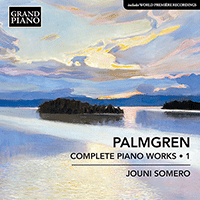
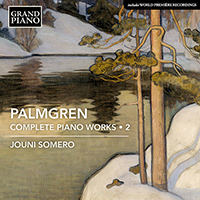
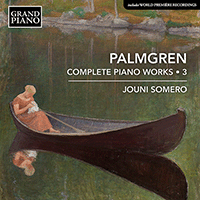
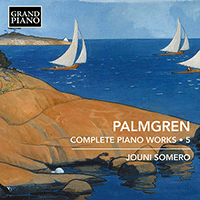
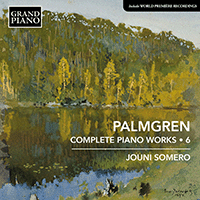
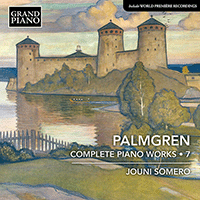
 Grand Piano has gained a reputation for producing high quality recordings of rare keyboard gems. Dedicated to the exploration of undiscovered piano repertoire, the label specialises in complete cycles of piano works by many lesser-known composers, whose output might otherwise have remained unknown and unrecorded.
Grand Piano has gained a reputation for producing high quality recordings of rare keyboard gems. Dedicated to the exploration of undiscovered piano repertoire, the label specialises in complete cycles of piano works by many lesser-known composers, whose output might otherwise have remained unknown and unrecorded.






